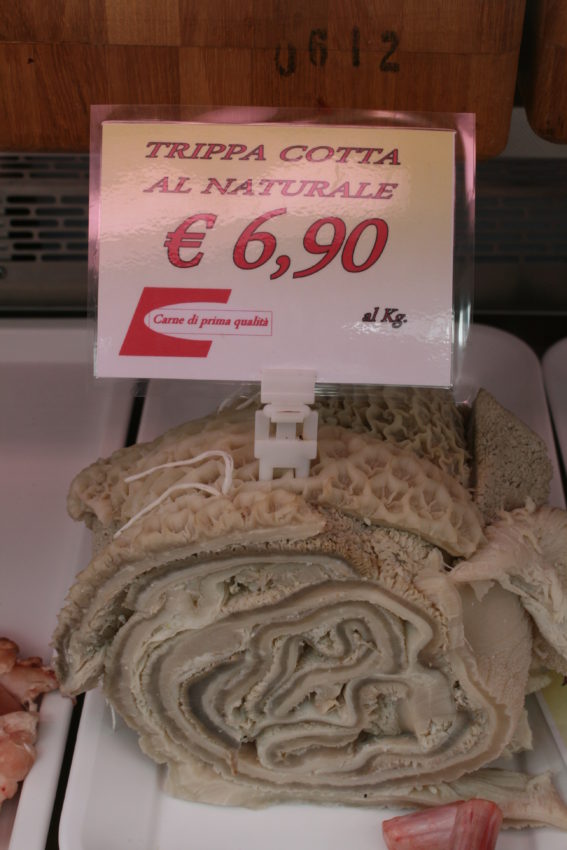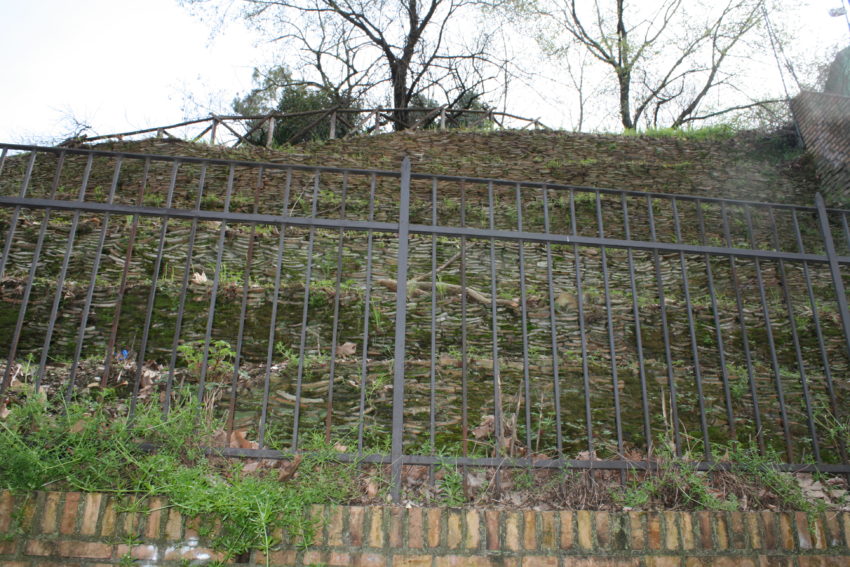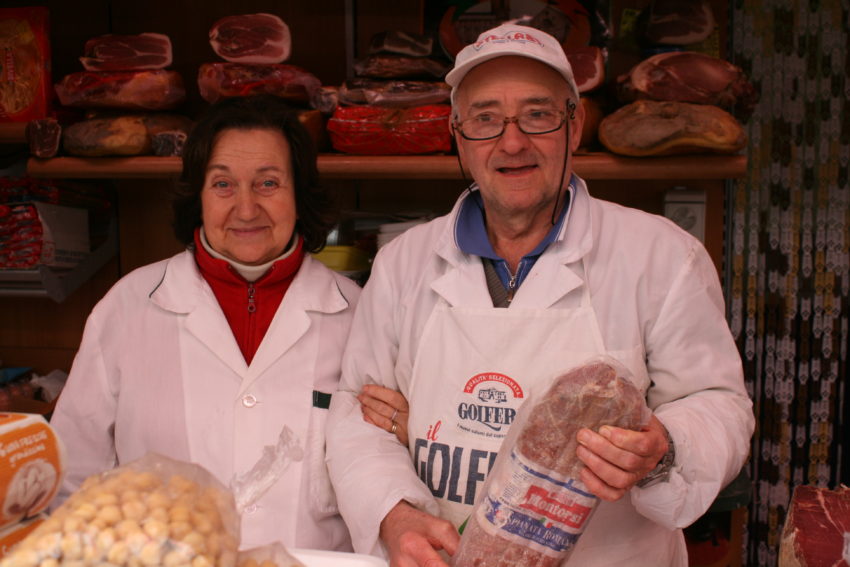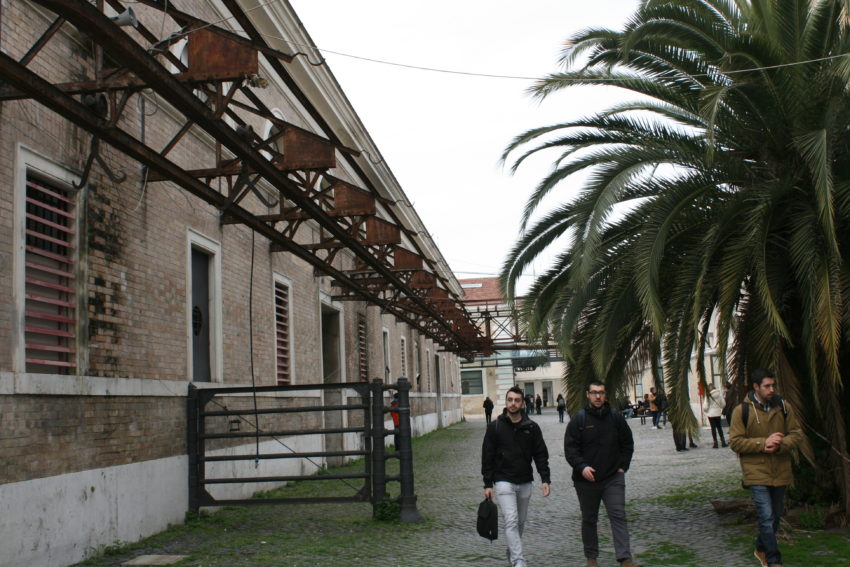Retired in Rome Journal: Testaccio gastro tour a bite of Rome’s tasty and disgusting past






SUNDAY, APRIL 13
Yesterday was one month since I moved into my new apartment in Testaccio. In the former working class quarters of Rome, in one of the true Roman neighborhoods, void of mass tourism, postcards and English menus, I now consider myself a local. I spend nearly every morning in Linari, one of the great pasticcerias in Rome with an entire display case of Italian pastries haunting me from a few feet away. It also has Wifi and since I still don’t have Internet, I now know every ingredient in a chocolate cornetto.
I have worn the bib eating the famed bucatini amatriciana at Da Bucatino where the round pasta drenched in meat sauce is so thick and the waiters so frantic you’ll likely, at some point in the evening, get faced by a winging noodle. I learned every night Pizzeria Remo is packed, noisy and as brightly lit as Yankee Stadium. It has some of the best thin, Roman-style pizzas in Rome and is one of the most unromantic places on earth. It’s a great place for a first date.
She won’t get too intimidated, and you won’t get too horny.
Located south of the fabled Aventino Hill where the Roman working class once lived and across the river from Trastevere where the new Roman hip live, Testaccio has a history few visitors know. Pronounced Tess-TAWTCH-io, it comes from the Latin word “testae,” which means “shard.” During the Roman Empire, this neighborhood served as the port for 90 percent of the food that came into Rome.The grain, olive oil and wine, among other food basics, came in terracotta pots which were discarded into the Tiber River, a foreshadowing of what Romans do to this day. Back then, the Tiber was packed with fish, swimmers and boatsmen, all leading precarious lives when floating chunks of dagger-sharp terracotta came flying down the river. To solve the problem, the workers threw all the pots onto a big hill, kind of like their local garbage dump.
The hill grew. And grew. And grew. Soon it became the landmark that it remains today: about an 80-foot mountain of broken clay pots. Grass growing over it all makes it one of the more attractive garbage dumps in existence.
And it’s four blocks behind my apartment building.
Back 2,000 years ago, Rome had 1 million people. Another city in Europe didn’t reach that mark until London — in the 1850s. But the Romans living in Testaccio weren’t wearing togas and drinking wine in gold goblets near the Roman Forum. Since well before Spartacus first laid down his hammer and picked up his sword instead (See: Slave Revolts That End Badly), Testaccio has been the living quarters of the working class. This is where the dock workers labored in the sun and where butchers hung massive sides of beef on giant meat hooks. It’s where the true Roman cuisine began. And it remains alive today. If you want tripe, the inner lining of a sheep’s stomach, you come to Testaccio. If you want oxtail stew, you come to Testaccio.
In Testaccio, when they kill an animal, they eat the whole carcass.
But it’s also where I found a 20-year-old olive oil that will make any piece of bread taste like chateaubriand, parmigiano reggiano so good I find myself grating it over my cereal and, of course,chocolate cornettos which I’ve developed an addiction bordering on crack cocaine. (The Linari staff automatically put out a cappuccino and chocolate cornetto when they see me walk in, sweating and itching the inside of my arm.)
To get a good history of this gastronomic kaleidoscope, I recently took a Testaccio food tour. Booked through Viator (http://www.viator.com/tours/Rome/Rome-Food-Walking-Tour/d511-5553ROMEFOOD?aid=se1), it was a short walking tour of my neighborhood with not nearly enough exercise to work off the nine small courses we were fed. A friend and I met our guide at Palumbi, an enoteca-birreria that features 400 beers and even more wines. The zesty guide packed with knowledge, Alexandra Bruzzese, is a 25-year-old Holy Cross grad with the bespectacled look of a sexy Ivy League grad student. She must be one of the most envied tour guides in Rome. While others are shuffling around the dusty remains of the Forum or explaining Renaissance art for the millionth time, she starts our tour with a cornetto at Barberini. In keeping with the Italian tradition that 75 percent of all businesses are family run, Barberini is in its third generation of family ownership. If I wind up in cornetto rehab (I hear Perugia, home of Baci chocolates, has one of the better facilities,) I’m blaming Bruzzese for contributing to my addiction. A cornetto is an Italian croissant but with a sugary crust and usually filled with chocolate, vanilla cream or marmalade. The great ones are warm with the chocolate melting in your mouth. If you walk by a pasticceria in Rome and see patrons’ chins covered in chocolate sauce, stop what you’re doing. Don’t put out the fire. The childbirth can wait. Go in and have the chocolate cornetto. Then moan like you’re having the greatest sex of your life.
We were given cappuccinos, and Bruzzese gave a valuable tip: If you want to avoid looking TOO MUCH like a tourist in Italy, NEVER EVER order a cappuccino after noon. Italians only drink them in the morning. One reason is Italians don’t digest milk well. A liter of milk will last them a week. In my fridge, it lasts 30 minutes. Another reason is they are, well, Italians. They are slaves to appearance.
We walked a block to Volpetti Piu where we were given pizzettas (little pizzas) and a big history lesson. I’ve read books on Italian food and visited the famed Da Michele pizzeria in Naples, considered by many as the best pizzeria in Italy, and know some of it, like it was invented in Naples in the 19th century. But Bruzzese added all kinds of interesting tidbits. Like tasty toppings on a pizza, dig into these morsels:
* Pizza was invented as a way to use all the leftovers from meals in Naples. Cheese wasn’t added until the 1940s.
* Pizza actually went to New York before it went to the rest of Italy. The first American pizzeria was Lombardi’s in New York in 1905. It didn’t reach Rome until World War II.
* Roman-style pizza has real thin crust. It isn’t heavy and isn’t greasy. It’s by far my favorite. The only places in Colorado I found close to it were at Pasta Jay’s in Boulder and Marco’s Coal-Fired Pizza in LoDo in Denver. During the war, Rome was poor. The reason Roman-style pizza is thin is because they rationed dough.
* Rome has 5,300 pizza-by-the-slice takeaway joints, known as “portare via.” Il Messaggero, Rome’s main newspaper, lists Volpetti Piu as having one of Rome’s top 10.
We moved on to the first edition of Volpetti. E Volpetti is a gourmet meat and cheese shop with prices more appropriate for Centro Storico but tastes that would’ve entertained Roman emperors. Opened 40 years ago by two brothers, it has 150 cheeses and 60 varieties of salami. It has a balsamic vinegar that’s 100 years old. It goes for 1,450 euros, so expensive and so good, Mr. Volpetti suggested you sip it. Don’t dare waste it on a piece of lettuce.
E Volpetti is where you can get the famed white truffles. They’re the valued mushrooms Italians — very rich Italians — shave onto their pasta and eggs and anything else that needs a little flavor. The white truffles in E Volpetti go for 1,000 euros a kilo. If that’s out of your price range, get the black truffles for 890. Then go get serious, SERIOUS psychiatric counseling. Nothing in the world of food is more overpriced. I’ve had truffles and my first thought was, “What’s the big deal?”
Instead, I got some 10-year-old balsamic vinegar and a giant chunk of parmigiano reggiano that tasted so rich, chewy and sharp, I didn’t want to ever defile it with a cracker. Parmigiano reggiano is the true king of grated Italian cheese. It takes 600 liters of milk to make one wheel and then they age it one to four years. If you want to impress your friends and spend a little less money, buy the Grana Padano. I had that at the VinItaly wine fair in Verona and I’ve been hooked ever since.
You can spend an hour in E Volpetti just looking around and learning. Giant pig legs hang from the ceiling like hunting trophies. Italians have been eating prosciutto since the Middle Ages and here they even sell it with injections of Barolo, the rich red wine from the Piedmont region and arguably the best wine Italy produces.
The center of gastro Testaccio is the Mercato Testaccio. It’s a public market that began in 1911 and two years ago moved into a shining white building four blocks from my apartment. It features 103 family run vendors selling everything from plastic cookie trays to fresh pasta to gourmet paninos to too many different kinds of cheese to count. We met Cesene, a craggy, silver-haired, third-generation butcher who still proudly displays a newspaper photo of him in the 1970s. Inside his glass case is the classic tripe. It sells for 6.90 euros which is a steal if you can get past eating what looks like a dead, 20-foot snake coiled into a giant ball.
Vegetable stands dominate the market and tomatoes dominate vegetable sands. In Rome, tomatoes are so sweet I eat them like apples. You don’t need organic tomatoes to get that flavor and after March you never buy tomato sauce for your pasta. Smashed up, fresh tomatoes will do. Bruzzese gave us another zinger. Tomatoes arrived in Italy from Mexico in 1496 but Italians didn’t eat them for 200 years. Why? They were told they were poisonous. Behind this slanderous claim was the Vatican which had heard tomatoes were an aphrodisiac. Maybe they are.
The average Italian eats 90 kilograms of tomatoes a year.
A block away from the market are the remains of Testaccio’s old slaughterhouse. It’s the size of 15 American football fields and at one point employed 5,000 workers. Often the workers were paid in meat. Of course, they were given all the lousy cuts which is why you see pig stomach behind glass in the market today. In the 20th century, Testaccio became more residential and the locals started complaining about living next to rotting animal corpses. The slaughterhouse closed in 1975. Today it houses a music school and a demonstration hall which this summer has displayed the history of my beloved A.S. Roma soccer team. I firmly believe Roma’s current second-place standing is due to its history displayed in a former slaughterhouse where the squeals of murdered pigs and cows could be heard clear up the Tiber River. But that’s just the romantic in me.
We finished the tour at Giolitti, the first gelateria in Rome. One of my favorite free-lance stories was for Silver Kris, the in-flight magazine for Singapore Airlines. It was 1,500 words on gelato. I ate gelato around Rome for three straight days. I remember interviewing the owner of Giolitti and asking him what he liked most about gelato. He got this misty look in his eye and said, in a thick Italian accent, “You know, when you walk around a piazza, and you have your lover in one hand and a gelato in the other, and you lick. And you Lick. And you LICK! THAT is love!”
The pen was paralyzed in my hand as I was bleating, “Yeah? YEAH? YEAH?!!!!
Anyway, Bruzzese gave us all some tips about buying gelato, most of which I knew. First, you judge gelato by its color. Gelato uses real fruit. What color is a banana, truly? It’s kind of gray, isn’t it? True banana gelato has kind of a dull, grayish tint. But it has 10 times the flavor of the banana gelato the color of a Yellow taxi cab. A true pistachio is kind of an earthy green. It’s not the color of a lime. Second, 80 percent of the gelato in Rome is fake. You can tell by the tubs. If they’re piled high like, as Bruzzese says, “a little ski slope,” skip it. They’re filled with air from powder injected. This gelato lasts two to three days. True gelato is sold packed into tubs where they’re flat at the rim. True gelato has the shelf life of romaine lettuce.
I’m writing this in Linari where I’m within three strides of a display case filled with cornettos, cannolis, cream puffs and chocolate-flecked baked meringue. But boy, could I use a gelato and a woman’s hand to hold.


April 14, 2014 @ 11:31 am
HI John I have been to many places in Italy but never Rome. I would love to visit you this summer . That is if you would like me to. When I saw the Tripe I remembered the French like that too. Not for me but so many of the other foods you have wrote about sound yummy. Happy Easter.
Sent from my iPad